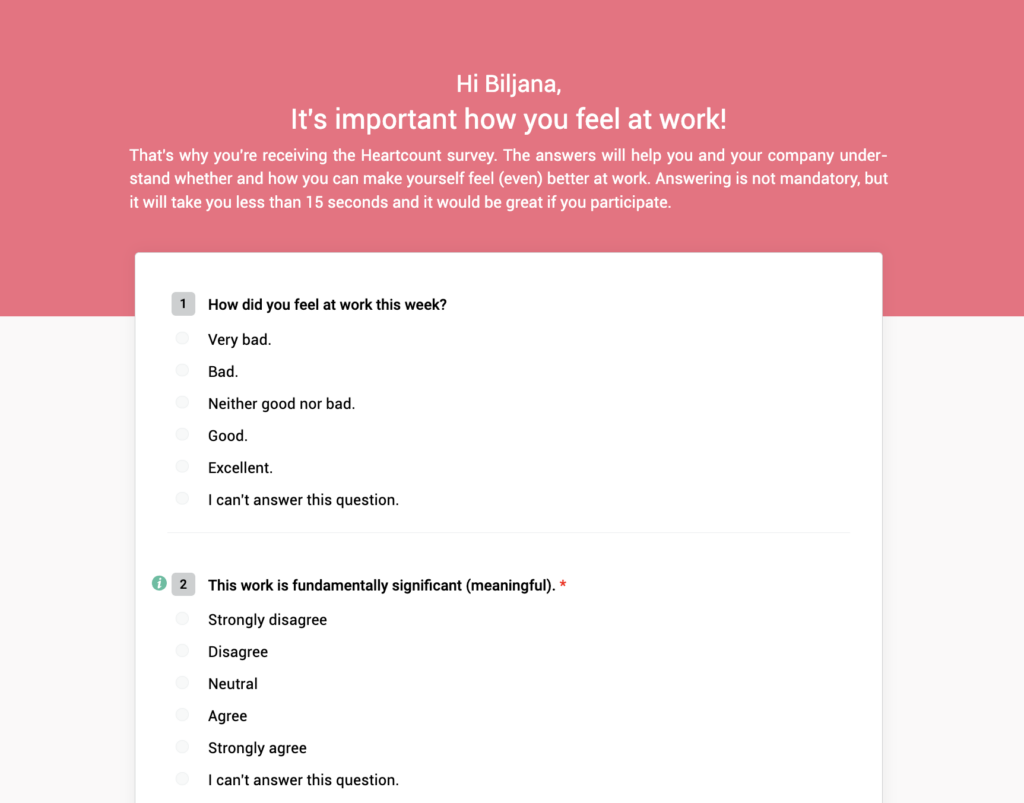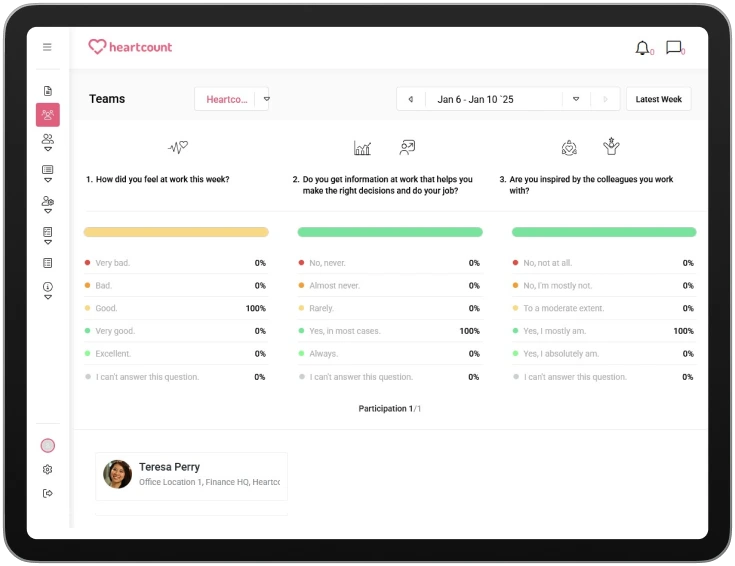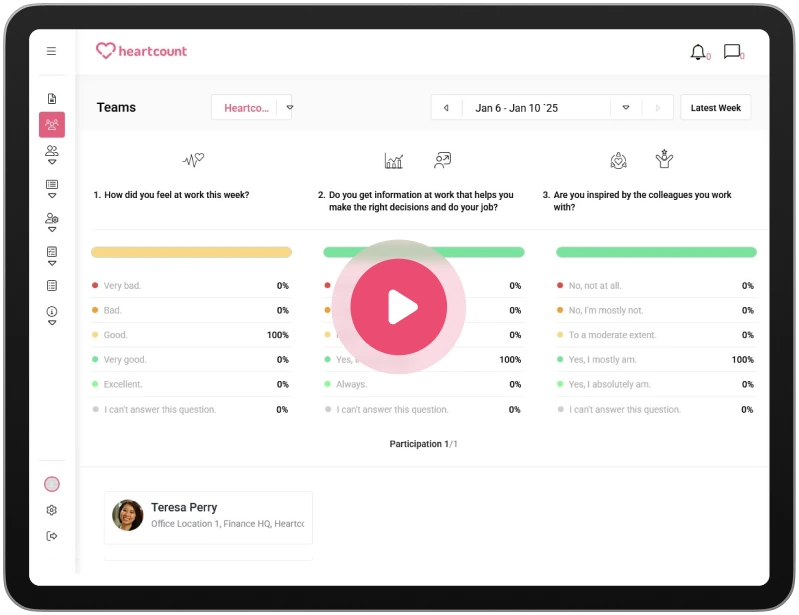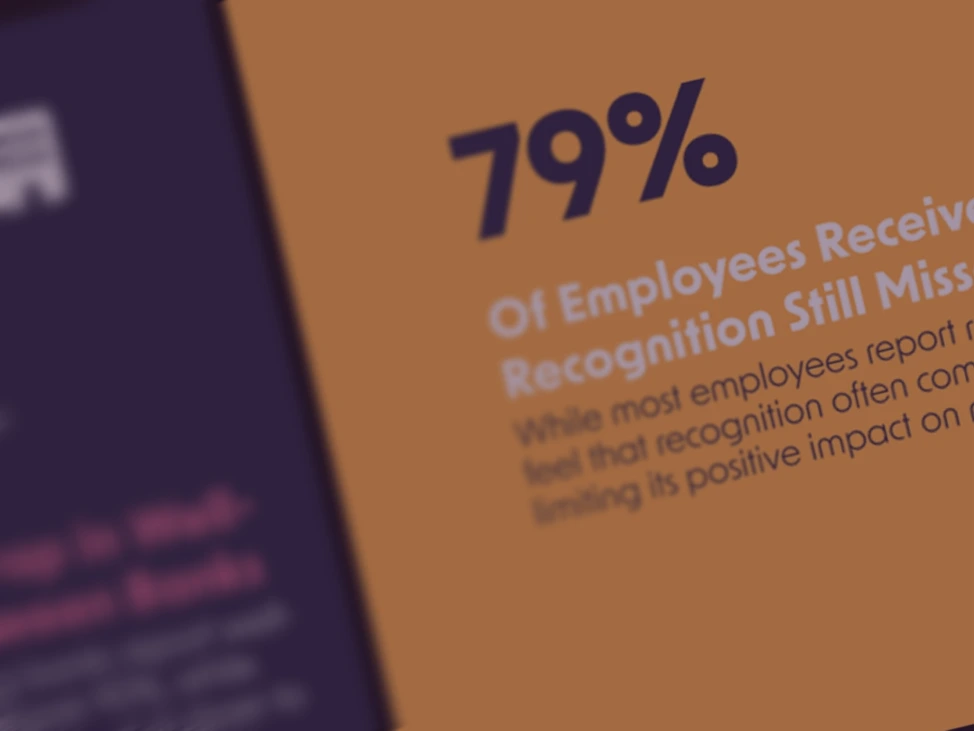ROI of Employee Engagement: How to Measure, Prove, and Improve It in 2025

Employee engagement has always mattered, but in 2025 it sits at the centre of every conversation about performance, retention and organisational health. HR teams are navigating tighter budgets, rising burnout, shifting expectations and constant change. Leaders want clarity. Finance wants numbers. And HR needs a way to show, with confidence, how engagement connects to real business outcomes.
The truth is simple. Engagement ROI is measurable. It shows up in the places where work either flows or breaks down: turnover, absenteeism, productivity and customer experience. When engagement improves, these metrics follow. When it slips, costs rise. You can see the difference in the numbers long before it appears in an annual report.
This guide breaks down how to measure that return and how to turn engagement into something predictable rather than reactive. Throughout the process, you’ll also see how HeartCount supports the weekly rhythm that makes engagement sustainable. Not with heavy dashboards or complicated workflows, but with simple signals that help teams understand what’s changing and act early.
The goal is straightforward. Give HR and People Ops a clear way to explain the value of engagement, prove its impact and build a culture where the return grows year after year. When you step back and connect these shifts to outcomes leaders care about, the ROI of employee engagement becomes much easier to understand and articulate.
-
1.What Is Employee Engagement ROI and Why It Matters
-
2.How to Measure the ROI of Employee Engagement
-
3.Engagement ROI Formula (No Tools Needed)
-
4.How to Prove ROI to Executives and Stakeholders
-
5.What Drives a High Return on Engagement
-
6.How HeartCount Helps HR Teams Maximize ROI
-
7.Continuous ROI Tracking: The Listen → Diagnose → Act Loop
-
8.Conclusion: ROI of Employee Engagement
-
9.FAQ
Employee engagement has always mattered, but in 2025 it sits at the centre of every conversation about performance, retention and organisational health. HR teams are navigating tighter budgets, rising burnout, shifting expectations and constant change. Leaders want clarity. Finance wants numbers. And HR needs a way to show, with confidence, how engagement connects to real business outcomes.
The truth is simple. Engagement ROI is measurable. It shows up in the places where work either flows or breaks down: turnover, absenteeism, productivity and customer experience. When engagement improves, these metrics follow. When it slips, costs rise. You can see the difference in the numbers long before it appears in an annual report.
This guide breaks down how to measure that return and how to turn engagement into something predictable rather than reactive. Throughout the process, you’ll also see how HeartCount supports the weekly rhythm that makes engagement sustainable. Not with heavy dashboards or complicated workflows, but with simple signals that help teams understand what’s changing and act early.
The goal is straightforward. Give HR and People Ops a clear way to explain the value of engagement, prove its impact and build a culture where the return grows year after year. When you step back and connect these shifts to outcomes leaders care about, the ROI of employee engagement becomes much easier to understand and articulate.
What Is Employee Engagement ROI and Why It Matters
Research in organisational psychology has shown for almost two decades that engagement drives measurable business outcomes. An influential meta-analysis by Christian, Garza, and Slaughter, published in Personnel Psychology, reviewed data from over 90 independent studies and found that engaged employees deliver a .42 correlation with overall performance and a .30 correlation with reduced turnover intention. In practical terms, this means teams with stronger engagement are meaningfully more productive and significantly less likely to leave.
Another often-cited study in the Journal of Occupational and Organizational Psychology found that employees with high engagement also show lower absenteeism, better work quality, and higher resilience under pressure, all of which have direct financial impact. This is the foundation of engagement ROI. When people feel focused, supported and committed, the organisation gains measurable returns through lower churn, fewer absence days and more stable output.
A useful way to understand this is by looking at how employee experience shapes engagement over time. A strong experience creates the conditions for engagement, and engagement delivers the behavioural changes that produce ROI. This relationship becomes clearer when you look at how employee experience and engagement interact across the employee lifecycle, something explored in more depth through work on employee experience and employee engagement.
Engagement vs Satisfaction: Key Differences That Affect ROI
Although they are often grouped together, satisfaction and engagement refer to different psychological states that produce different financial outcomes.
Here is the distinction in simple terms.
Job satisfaction
- Reflects comfort and contentment
- Predicts stability but not necessarily high performance
- Often influenced by benefits, environment, and interpersonal climate
- Useful for retention but limited as a driver of productivity
Work engagement
- Reflects vigour, dedication and absorption in work
- Predicts performance, creativity, speed and accuracy
- Strongly tied to motivation and personal investment in outcomes
- Directly influences ROI through output and behaviour
Christian, Garza and Slaughter’s work showed that engagement has more than twice the performance impact of satisfaction. Satisfaction can make someone stay. Engagement determines how they perform while they stay, which is the real source of ROI.
Business Impacts of Engaged vs Disengaged Teams
The difference between an engaged team and a disengaged one is easy to spot once you look closely at how the work actually gets done. Engaged employees show up with more focus, take greater care in their tasks and recover faster when the pressure rises. Their work has fewer stops and starts, and projects move with a steadier rhythm. That consistency is what lifts performance in a way leaders can feel and finance teams can measure.
Retention follows the same pattern. When people feel connected to their work, they stay. They build stronger relationships, carry more context and make better decisions because they aren’t constantly resetting or handing things over. Losing that stability is expensive. Keeping it creates an immediate return.
Attendance tells another part of the story. Teams with strong engagement tend to have fewer last minute absences, not because they never struggle, but because they are more supported and more resilient. It means fewer gaps on the schedule and fewer disruptions to daily operations.
And then there is the customer impact. Engaged service and sales teams communicate with more care. They respond with more ownership. They follow through. Clients feel the difference and so does the business. Loyalty strengthens, renewals are smoother and revenue becomes more predictable.
Put simply, engagement changes how work feels day to day, and those small behavioural shifts compound into real financial results.
Common Misconceptions About ROI of Engagement
Misunderstandings about engagement often lead organisations to underestimate its financial impact. Three misconceptions appear most often.
Misconception 1: Engagement cannot be quantified
Engagement correlates meaningfully with performance, absence patterns and turnover intention. Each of these has a calculable cost. Once those costs are connected to improvements in engagement, ROI can be modelled with standard financial formulas.
Misconception 2: Perks and surface benefits increase ROI
Perks may boost satisfaction temporarily, but engagement comes from resources such as fair recognition, autonomy, clear goals and supportive leadership. These are the drivers that shift behaviour and create business value.
Misconception 3: Annual surveys capture ROI accurately
Engagement fluctuates weekly based on workload, clarity and team dynamics. Annual surveys miss these shifts, making it hard to connect actions to outcomes. Without regular insight, ROI becomes impossible to measure accurately.
Clearing up these misconceptions sets the foundation for calculating engagement ROI with confidence and presenting it in a way that resonates with executives and finance teams.

How to Measure the ROI of Employee Engagement
The easiest path for measuring ROI on employee engagement is to look at the places where engagement quietly shapes day to day business results. You are not trying to capture an abstract feeling. You are tracking shifts in behaviour that change costs, speed and stability. Once you understand where those shifts happen, the numbers fall into place.
Employee Turnover
Turnover is the heavyweight in any ROI conversation. When engagement improves, fewer people leave, which immediately cuts hiring spend and protects the knowledge teams rely on. Every retained employee saves time, budget and momentum. Leaders usually feel the impact long before they calculate it, because the cost of employee engagement work is almost always significantly lower than the cost of losing and replacing talent.
This is why even small drops in voluntary turnover matter. The cost to replace a single person is high, especially in roles with long onboarding or specialised knowledge. Over a year, the savings become hard to ignore. If you want the mechanics behind this, the overview on employee turnover and retention breaks down how engagement keeps teams stable.
Absenteeism and Presenteeism
Absenteeism drains money in slow, quiet ways. A single unexpected absence might not seem like much, but repeated gaps throw off schedules and push work onto already stretched teams. When engagement rises, absence rates usually fall because people feel more supported and more grounded in their work.
Presenteeism is different. It is the productivity leak you don’t see on a spreadsheet. Someone is present but mentally elsewhere, and their output slips. Engagement lifts this fog. People show up with clearer focus and steadier energy, which often does more for ROI than major process changes.
Productivity and Performance
You can feel the productivity impact of engagement even before you measure it. Work flows more smoothly. Handovers are cleaner. Teams recover from setbacks faster and move with more intention. These shifts sound small, but they reduce rework, shorten cycle times and lower operating costs.
What makes this powerful is that you do not need dramatic improvements to see financial value. A little more focus here, a faster response there. Over hundreds of workdays, those small changes stack up.
Customer Satisfaction and Retention
Customer experience is often the clearest mirror of employee engagement. Engaged employees listen differently. They take ownership. They follow through. Customers feel that, and it shows up in loyalty, renewal rates and word of mouth.
In businesses with recurring revenue, even a tiny uptick in retention can create a big long term return. Engagement plays a quiet but meaningful role in that equation.
Revenue per Employee and Profitability
Revenue per employee rises when teams perform well, stay longer and waste less time switching roles or correcting mistakes. Engagement supports all of that. It strengthens the consistency and predictability that finance teams love because it stabilises margins.
The connection is not flashy, but it is reliable. Healthier teams produce healthier numbers.
ROI Metrics Table (with Example Formulas)
While many HR teams rely on an employee engagement ROI calculator, the underlying formula is simple enough to calculate manually. Below is a compact table you can use as a reference point. It turns engagement changes into financial numbers without requiring any complex tools.
| ROI Component | What You Measure | Example Formula |
| Turnover savings | Drop in voluntary turnover and cost per replacement | Turnover reduction × headcount × replacement cost |
| Absenteeism savings | Fewer absence days and cost of lost labour | Saved absence days × daily cost × headcount |
| Presenteeism savings | Productivity regained when disengagement falls | Headcount × average salary × productivity lift (%) |
| Productivity gains | Output increase after engagement improvements | Revenue per employee × uplift (%) × employees impacted |
| Customer impact | Higher retention or renewal value | Change in retention × average customer value |
| Overall ROI | Final return on investment | (Total benefits − total costs) ÷ total costs × 100 |
When you connect these data points consistently, it becomes much easier to increase the ROI on employee engagement without relying on large or expensive programs.
COLLECT
Engagement ROI Formula (No Tools Needed)
You do not need a specialised platform or financial software to calculate the ROI of employee engagement. The fundamentals rely on simple inputs you already have. Turnover numbers. Absence data. Productivity benchmarks. Customer retention. When you combine these with changes in engagement over time, the return becomes clear.
The goal here is not to create a perfect model. It is to give leaders a grounded way to connect people data with business outcomes, something HR teams are asked for more often than ever.
What You’ll Need: Inputs and Benchmarks
Every engagement ROI calculation starts with three categories of information.
First, people metrics that show what has changed. Has voluntary turnover gone down? Are absence levels steady or improving? Has the team’s engagement score risen noticeably across a quarter? Clear, well structured input questions make this easier, and the breakdown of engagement survey questions helps teams choose signals that actually reflect behaviour.
Second, cost and output data. This can come from HRIS, payroll, finance or simple spreadsheets. You need the cost of replacing an employee, a rough estimate of daily labour cost and a sense of revenue or output per employee. The numbers do not need to be perfect. They just need to be consistent.
And third, benchmarks that help you set realistic expectations. These usually come from your own historical data rather than external reports. If your company historically loses fifteen percent of its staff each year and you bring that down to twelve percent, that three point difference is your baseline for the ROI calculation.
Once you have these three pieces, everything else falls into place.
Sample ROI Calculation Walkthrough
Here is a simple walkthrough using numbers you might see in a mid sized company.
Imagine a team of one hundred employees. Their annual voluntary turnover has dropped from fifteen to twelve percent after a year of focused engagement work. That means three fewer people left than expected. If the cost to replace one employee averages twelve thousand euros, the company has saved thirty six thousand euros in turnover alone.
Now look at absenteeism. Let’s say unscheduled absence dropped by half a day per employee over the same period. That is fifty saved workdays. If the daily labour cost is two hundred euros, that is another ten thousand euros protected.
Add a conservative productivity uplift of just two percent across the team. If revenue per employee sits at ninety thousand euros, a two percent lift produces an additional one thousand eight hundred euros per employee. Multiply that by one hundred people and you have one hundred eighty thousand euros in performance based return.
Put the pieces together. Turnover savings plus absenteeism savings plus productivity gains. Then compare that total to the cost of the engagement initiatives you invested in. That is your ROI. There is no magic. Just clear cause and effect.
How HeartCount Pulse Data Supports the ROI Formula
HeartCount does not replace your HRIS or financial systems, and it should not be positioned as a full ROI calculator on its own. What it provides is the engagement side of the equation. The signals. The patterns. The weekly movement that shows whether your people initiatives are having an effect long before the financial results appear.
Weekly pulse data makes it easier to track which teams are gaining momentum and which ones need support. Trends in wellbeing, recognition and workload show where churn risk might rise. Sentiment shifts help you predict attendance challenges before they hit the schedule. These early indicators make your ROI calculation far more accurate because you are not relying on broad annual snapshots. You are working with live context.
When you combine HeartCount insights with turnover numbers from your HRIS, absence records from payroll and revenue data from finance, the formula becomes powerful. You get a more honest picture of what is improving, what is stalling and where your investment is paying off. The tool does not calculate ROI for you, but it gives you the clearest view of whether engagement is moving in the right direction.
How to Prove ROI to Executives and Stakeholders
Many HR teams struggle with how to prove the ROI of employee engagement, especially when leadership wants numbers rather than sentiment. Executives respond to clarity, risk reduction and forward movement, not pages of survey charts. When you frame engagement through cost, stability and performance, the conversation shifts. You are no longer asking for budget. You are explaining why the business cannot afford to ignore the patterns happening inside its teams.
Metrics That Matter to Finance and Leadership
Executives and finance teams think in terms of levers that move the business. They want to know which changes protect profit, reduce volatility and support long term execution. That is why the strongest engagement ROI cases focus on a handful of metrics.
Start with voluntary turnover because it has immediate financial weight. Fewer exits mean fewer replacements, lower onboarding cost and a more predictable operational rhythm. Leaders understand this instantly.
Add absence patterns. Stability matters. Unplanned absences disrupt schedules, push overtime and create avoidable inefficiencies. A downward trend here signals a healthier team and a healthier cost base.
Then bring in productivity and output quality. These are often the clearest signs that engagement work is landing. Leaders feel the difference before they see it on a spreadsheet. Fewer slowdowns, cleaner handoffs, smoother cycles. When you can connect these shifts to performance indicators, the ROI case becomes real.
The final layer is customer impact. Renewal rates, complaint volumes, support load, time to resolution. All of these improve when engagement rises, and they directly influence revenue stability.
These metrics speak the language of leadership. They tie people initiatives to business outcomes without overclaiming.
Framing ROI in Terms of Risk, Growth and Retention
Executives do not only evaluate returns. They evaluate risk. Engagement plays a quiet but powerful role in risk reduction because it stabilises behaviour. When engagement rises, burnout decreases, conflict cools, and teams communicate more consistently. That lowers the chances of operational errors, customer escalation and sudden turnover spikes.
Framing engagement in terms of risk management makes the ROI case far more compelling. You are showing not just what the company gains, but what it avoids.
Then there is growth. High engagement makes teams more adaptable. They handle change better, execute faster and absorb pressure with fewer setbacks. Growth depends on people being able to move with the organisation rather than being overwhelmed by it. Engagement is what supports that movement.
Finally, retention. No growth strategy survives high churn. When people stay longer, institutional knowledge deepens, culture strengthens and leadership capacity expands. Retention is both a financial win and a competitive advantage.
When you use these three lenses, the ROI argument becomes more than a number. It becomes a strategic case.
What Drives a High Return on Engagement
A strong ROI on engagement isn’t the result of one big initiative. It comes from a set of habits that shape how people feel, communicate and recover from pressure. These habits compound. A little more clarity, a little more recognition, a little more support. Over time, they shift behaviour in a way that shows up directly in retention, productivity and customer outcomes.
These are the drivers that reliably create the biggest return.
Weekly Feedback and Pulse Surveys
Weekly feedback is one of the most powerful levers for ROI because it keeps leaders close to what employees are actually experiencing. Engagement changes quickly. Workload, clarity, conflict, stress. If you only ask once or twice a year, you will miss the patterns that matter.
Regular pulses give teams space to express what is working and what is slipping. They help managers intervene before disengagement turns into burnout or turnover. They also give leaders enough data to respond with confidence, not guesswork. When employees feel heard consistently, engagement rises and the financial impact follows.
Recognition and Motivation Loops
Recognition is one of the most reliable ways to lift engagement because it reinforces meaningful behaviour in the moment. When people feel their effort is noticed, they show up with more focus, more care and a stronger sense of ownership. Teams communicate more openly, recover faster during stressful cycles and maintain healthier momentum.
The strongest recognition habits are simple and frequent. They highlight specific contributions rather than relying on broad praise. Over time, this builds trust and strengthens team culture because people feel their work genuinely matters.
HeartCount supports this through its built-in employee recognition feature. It gives teams an easy, natural way to share appreciation throughout the week, which helps recognition become part of everyday work rather than something reserved for performance conversations. When appreciation flows consistently, engagement rises and so does the return on that investment.
Manager Enablement and Nudges
A lot of engagement ROI comes down to how managers show up. Clear expectations, follow-through, consistent check-ins, conversations that feel human rather than transactional. Managers are the bridge between strategy and lived experience.
This is where nudges help. Small prompts that remind managers to check in with someone, follow up on a promise, or address a brewing issue. It sounds simple, but those micro-moments prevent disengagement long before it becomes a turnover risk. Manager behaviour is one of the strongest predictors of ROI because it influences nearly every outcome: performance, belonging, burnout prevention, and stability.
Psychological Safety and Inclusion
Psychological safety is the engine that lets engagement turn into performance. When people feel safe to speak openly, ask questions, admit mistakes or challenge unclear decisions, the quality of work improves. Teams solve problems faster and catch issues before they blow up.
Inclusion strengthens that safety. When people feel seen and valued, the energy they bring to work changes. They share more ideas, commit more deeply to outcomes and lean toward collaboration instead of avoidance. These behaviours create reliability, and reliability is a major contributor to ROI.
Tech That Helps (Without Overwhelming)
Technology contributes to engagement ROI when it simplifies the way teams communicate and understand each other. Tools should reduce effort, not add more. The best support is the kind that blends into existing routines and helps managers stay close to how people are feeling without creating noise or complexity.
HeartCount was designed with that in mind. Features like the employees overview give leaders a clear, real time view of sentiment and participation across their teams. Instead of digging through reports or waiting for quarterly feedback, managers can see meaningful shifts as they happen and respond before issues grow into costly outcomes.
When technology works quietly in the background and gives people the information they need at the right moment, engagement improves naturally. The return follows.
Persona Based ROI Checklist (Quick Wins by Role)
Different roles influence engagement ROI in different ways. These quick wins help each group focus on the actions that create the strongest return.
For HR and People Ops
✅ Track pulse trends weekly instead of relying on annual surveys
✅ Pair engagement signals with turnover and absence patterns to identify high risk teams
✅ Equip managers with simple follow up templates so feedback leads to action
For Managers
✅ Hold short, focused check ins on a weekly or biweekly basis
✅ Recognise specific contributions rather than giving broad praise
✅ Use pulse insights to support people proactively instead of waiting for issues to escalate
For Executives
✅ Anchor engagement work to priorities like retention, customer stability and operational resilience
✅ Review engagement trends alongside financial metrics to spot early risks
✅ Treat engagement as a leading indicator of future performance, not a soft HR metric
When each role focuses on the levers that belong to them, engagement becomes easier to sustain and its return becomes much clearer.

UNDERSTAND
How HeartCount Helps HR Teams Maximize ROI
Every organisation wants stronger engagement, but the real challenge is catching the early signals before they become expensive. HeartCount helps teams do exactly that. Not by flooding you with dashboards or reports, but by giving you a steady rhythm of insight you can actually act on. Week after week, you see what’s shifting, where energy is rising and where it might be slipping.
Real Time Burnout and Disengagement Alerts
Burnout rarely announces itself. Sometimes it’s a small dip in motivation. Sometimes it’s a sudden drop in focus. And sometimes it’s just a feeling that something is off. HeartCount picks up those early changes. You notice patterns sooner. You step in sooner. And problems stay manageable instead of spiraling into resignations or prolonged absence.
Anonymous Feedback Loops That Scale
Not every concern is something people want to say out loud. That’s normal. Anonymous comments give employees a way to be honest without worrying about how it will land. For HR, this context is gold. It explains why sentiment moved the way it did, and it makes it easier to fix the root of the problem instead of treating the symptom.
Built In Templates for Engagement Action Plans
Managers want to respond well, but many simply do not know where to start. HeartCount gives them structure without making it complicated. A few practical templates. A few conversation prompts. Enough to help them follow up quickly and consistently. And that consistency is what builds trust over time. It’s also what keeps engagement rising instead of slipping back.
Fast Rollout With No IT Required
Some tools stall engagement before they even launch because setup takes forever. HeartCount avoids that trap. Once the first pulse goes out, the system is already doing its job. No delays. No training marathons. People start sharing. Managers start learning. HR starts seeing movement.
Connects With Slack, Teams and Your HRIS
Engagement tools only work when people actually use them. By living inside Slack, Teams and the systems your organisation already depends on, HeartCount removes effort from the process. Employees respond where they already are. Managers see insights without hunting for them. Adoption becomes natural instead of forced.
How HeartCount’s Features Support ROI
The heart of the ROI story is insight. Not once a quarter. Not once a year. Steady, reliable, week by week insight. HeartCount’s automated pulse surveys make that possible. Three questions a week. Fast responses. Honest signals.
Those signals get even more powerful when viewed through HeartCount’s real time data insights. You see trends across teams. You spot hidden risks. You recognise where engagement is improving and where you need to lean in a little more.
This is what makes engagement measurable. Predictable. And ultimately tied to the outcomes leaders care about most.
Continuous ROI Tracking: The Listen → Diagnose → Act Loop
Engagement ROI isn’t something you calculate once and file away. It moves. It grows. It dips. It reacts to team dynamics, workload, leadership changes, stress cycles and everything in between. The companies that consistently see a strong return are the ones that treat engagement as a weekly practice, not a quarterly project.
The Listen → Diagnose → Act loop keeps that rhythm steady. Short. Practical. Repeated until it becomes muscle memory.
How to Track ROI Quarterly With Pulse Metrics
Quarterly reviews work best when they’re built on weekly signals. HeartCount’s pulse data builds that foundation. Instead of relying on outdated observations or intuition, HR gets a timeline. A story. A clear view of how engagement changed over the past twelve weeks.
You can see where wellbeing dipped, where motivation picked up, where teams felt more supported and where things tightened or stalled. Patterns become clearer at this scale. Especially when you pair engagement trends with turnover numbers, onboarding progress or team performance.
A single quarter is usually enough time to spot small wins and early risks. It’s also the perfect window for mid-course corrections before the year runs away from you.
Avoiding Vanity Metrics: What to Cut
Some metrics look impressive but do nothing for ROI. Participation rates. Total comments. Generic satisfaction scores. They’re nice to have, but they don’t explain behaviour. They don’t predict outcomes.
What matters is movement. Where engagement went up or down, even slightly. Which teams show early signs of stress. Where recognition patterns disappeared. Where wellbeing shifted after a big push or a tight deadline.
And burnout. Always burnout. A spike in emotional exhaustion is one of the fastest ways to lose productivity and stability. The breakdown of employee burnout shows how quickly it affects performance, attendance and attitude. Vanity metrics hide this. Real metrics reveal it.
Cut anything that distracts. Keep everything that changes behaviour.
Tactics to Course Correct in Real Time
Course correction doesn’t need to be dramatic. Most of the time it’s a small pivot. A quick manager check in. A load balancing conversation. A recognition moment that brings someone back into the fold. Tiny shifts, but made early enough to matter.
The Listen → Diagnose → Act loop makes these adjustments feel natural rather than reactive. You listen through weekly pulses. You diagnose by pairing engagement signals with what you’re seeing on the ground. And you act with the smallest meaningful intervention, not a big initiative that lands months too late.
Over time, this rhythm creates stability. Engagement stops spiking and crashing. It evens out. That consistency is what produces a reliable return, quarter after quarter.
ACT
Conclusion: ROI of Employee Engagement
Measuring the ROI of engagement isn’t about proving that people matter. Everyone already knows they do. It’s about showing what actually changes when people feel supported, recognised and connected to their work. Lower turnover and fewer absences. More stable performance. Better customer outcomes. You can see those shifts in the numbers long before they show up in annual reports.
HeartCount helps teams get there by creating a steady rhythm of listening and action. When you understand how sentiment moves week to week, you respond earlier, you make better decisions and you prevent small issues from becoming expensive ones. That is where the return comes from. Not from perks or one-off programs, but from the everyday habits that shape how people feel at work.
Engagement becomes easier to manage when you measure it regularly. ROI becomes easier to prove when you link those insights to the outcomes leadership cares about. And once the loop is in motion, you see the difference everywhere: in stability, in culture and in the numbers that matter at the end of the year.
If you want to see how this works in practice, you can try HeartCount with your team and follow the data week by week.
FAQ
How do you calculate ROI for employee engagement?
By comparing the financial benefits of improved engagement to the cost of the initiatives. Use this formula: (Total benefits minus total costs) divided by total costs, multiplied by 100.
What is considered a good ROI from engagement work?
Even small shifts create strong returns. A few percentage points of reduced turnover or a slight lift in productivity often delivers meaningful financial impact.
What if engagement is high but retention is still low?
It usually means the issue isn’t engagement. Factors like pay, workload or career paths may be driving exits. Engagement helps diagnose the gap, but it isn’t the only variable.
Are annual surveys enough to track ROI?
No. Annual surveys miss the weekly changes that influence performance and cost. Pulse data gives a more accurate view and makes ROI easier to track.












